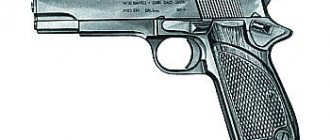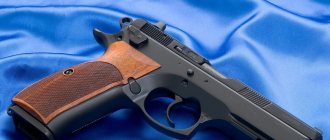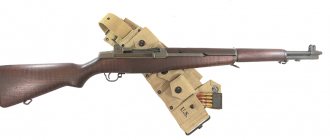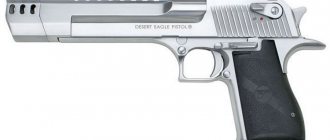By the end of the 30s, almost all participants in the coming world war had formed common directions in the development of small arms.
The range and accuracy of the attack was reduced, which was compensated by the greater density of fire. As a consequence of this, the beginning of mass rearmament of units with automatic small arms - submachine guns, machine guns, assault rifles. Accuracy of fire began to fade into the background, while the soldiers advancing in a chain began to be taught shooting on the move. With the advent of airborne troops, the need arose to create special lightweight weapons.
Maneuver warfare also affected machine guns: they became much lighter and more mobile. New types of small arms appeared (which was dictated, first of all, by the need to fight tanks) - rifle grenades, anti-tank rifles and RPGs with cumulative grenades.
Small arms of the USSR World War II
On the eve of the Great Patriotic War, the rifle division of the Red Army was a very formidable force - about 14.5 thousand people. The main type of small arms were rifles and carbines - 10,420 pieces. The share of submachine guns was insignificant - 1204. There were 166, 392 and 33 units of heavy, light and anti-aircraft machine guns, respectively.
The division had its own artillery of 144 guns and 66 mortars. The firepower was supplemented by 16 tanks, 13 armored vehicles and a solid fleet of auxiliary vehicles.
Rifles and carbines
Three-line Mosin
The main small arms of the USSR infantry units of the first period of the war was certainly the famous three-line rifle - the 7.62 mm S.I. Mosin rifle of the 1891 model, modernized in 1930. Its advantages are well known - strength, reliability, ease of maintenance, combined with good ballistics qualities, in particular, with an aiming range of 2 km.
Mosin Three-Ruler
The Three-Ruler is an ideal weapon for newly recruited soldiers, and the simplicity of the design created enormous opportunities for its mass production. But like any weapon, the three-line gun had its drawbacks. The permanently attached bayonet in combination with a long barrel (1670 mm) created inconvenience when moving, especially in wooded areas. The bolt handle caused serious complaints when reloading.
After battle
On its basis, a sniper rifle and a series of carbines of the 1938 and 1944 models were created. Fate gave the three-line a long life (the last three-line was released in 1965), participation in many wars and an astronomical “circulation” of 37 million copies.
Sniper with a Mosin rifle (with a PE optical sight, model 1931)
SVT-40
At the end of the 30s, the outstanding Soviet weapons designer F.V. Tokarev developed a 10-round self-loading rifle cal. 7.62 mm SVT-38, which after modernization received the name SVT-40. It “lost weight” by 600 g and became shorter due to the introduction of thinner wooden parts, additional holes in the casing and a decrease in the length of the bayonet. A little later, a sniper rifle appeared at its base. Automatic firing was ensured by the removal of powder gases. The ammunition was placed in a box-shaped, detachable magazine.
The target range of the SVT-40 is up to 1 km. The SVT-40 served with honor on the fronts of the Great Patriotic War. It was also appreciated by our opponents. Historical fact: having captured rich trophies at the beginning of the war, among which there were many SVT-40s, the German army... adopted it for service, and the Finns created their own rifle on the basis of the SVT-40 - TaRaKo.
Soviet sniper with SVT-40
The creative development of the ideas implemented in the SVT-40 became the AVT-40 automatic rifle. It differed from its predecessor in its ability to fire automatically at a rate of up to 25 rounds per minute. The disadvantage of the AVT-40 is its low accuracy of fire, strong unmasking flame and loud sound at the moment of firing. Subsequently, as automatic weapons entered the military en masse, they were removed from service.
Submachine guns
PPD-40
The Great Patriotic War was the time of the final transition from rifles to automatic weapons. The Red Army began to fight, armed with a small number of PPD-40 - a submachine gun designed by the outstanding Soviet designer Vasily Alekseevich Degtyarev. At that time, PPD-40 was in no way inferior to its domestic and foreign counterparts.
Designed for a pistol cartridge cal. 7.62 x 25 mm, the PPD-40 had an impressive ammunition load of 71 rounds, housed in a drum-type magazine. Weighing about 4 kg, it fired at a rate of 800 rounds per minute with an effective range of up to 200 meters. However, just a few months after the start of the war, it was replaced by the legendary PPSh-41 cal. 7.62 x 25 mm.
PPSh-41
The creator of the PPSh-41, designer Georgy Semenovich Shpagin, was faced with the task of developing an extremely easy-to-use, reliable, technologically advanced, cheap to produce mass weapon.
PPSh-41
Fighter with PPSh-41
From its predecessor, the PPD-40, the PPSh inherited a drum magazine with 71 rounds. A little later, a simpler and more reliable sector horn magazine with 35 rounds was developed for it. The weight of the equipped machine guns (both versions) was 5.3 and 4.15 kg, respectively. The rate of fire of the PPSh-41 reached 900 rounds per minute with an aiming range of up to 300 meters and the ability to fire single shots.
PPSh-41 assembly shop
To master the PPSh-41, a few lessons were enough. It could easily be disassembled into 5 parts made using stamping and welding technology, thanks to which during the war years the Soviet defense industry produced about 5.5 million machine guns.
PPS-42
In the summer of 1942, the young designer Alexey Sudaev presented his brainchild - a 7.62 mm submachine gun. It was strikingly different from its “bigger brothers” PPD and PPSh-41 in its rational layout, higher manufacturability and ease of manufacturing parts using arc welding.
PPS-42
Son of the regiment with a Sudaev machine gun
PPS-42 was 3.5 kg lighter and required three times less manufacturing time. However, despite its quite obvious advantages, it never became a mass-produced weapon, leaving the PPSh-41 to take the lead.
DP-27 light machine gun
By the beginning of the war, the DP-27 light machine gun (Degtyarev infantry, 7.62mm caliber) had been in service with the Red Army for almost 15 years, having the status of the main light machine gun of infantry units. Its automation was powered by the energy of powder gases. The gas regulator reliably protected the mechanism from contamination and high temperatures.
The DP-27 could only fire automatically, but even a beginner needed a few days to master shooting in short bursts of 3-5 shots. Ammunition of 47 rounds was placed in a disk magazine with a bullet towards the center in one row. The magazine itself was mounted on top of the receiver. The weight of the unloaded machine gun was 8.5 kg. An equipped magazine increased it by almost another 3 kg.
Machine gun crew DP-27 in battle
It was a powerful weapon with an effective range of 1.5 km and a combat rate of fire of up to 150 rounds per minute. In the firing position, the machine gun rested on a bipod. A flame arrester was screwed onto the end of the barrel, significantly reducing its unmasking effect. The DP-27 was serviced by a gunner and his assistant. In total, about 800 thousand machine guns were produced.
Interesting Facts
Thanks to the successful ballistic solution of the 14.5 mm cartridge/weapon, the armor-piercing ability of an armor-piercing bullet achieved in practice when firing from KPV/KPVT (30 - 35 mm / 500 m / 0 deg. on RHA steel armor of the NATO standard) turned out to be so high that at real tactical distances of the order of 500-800 m, KPV/KPVT fire ensured reliable penetration of frontal armor and defeat of the main armored personnel carriers of a potential enemy, including the most popular armored personnel carrier M113 (USA). That is why, from the 1970s to the present, requirements for protection from 14.5-mm machine gun fire have been introduced in the TTZ for armored combat vehicles of the BMP, BTR, BRDM, and light tank types created in NATO countries. Moreover, for infantry fighting vehicles - to protect the side projection of the vehicle with D 100-200 m. Accordingly, the thickness of the sides of the armored fighting vehicle in the monolithic version of steel armor is 35-45 mm (the last figure is the lower side of the Marder 1 infantry fighting vehicle). This was one of the reasons for the almost double combat weight of the main NATO infantry fighting vehicles "Marder A3" and M2 A3 "Bradley" relative to Russian infantry fighting vehicles. [ source not specified 177 days
]
- ZPU-4
- BRDM-2
Small arms of the Wehrmacht of World War II
The main strategy of the German army is offensive or blitzkrieg (blitzkrieg - lightning war). The decisive role in it was assigned to large tank formations, carrying out deep breakthroughs of the enemy’s defenses in cooperation with artillery and aviation.
Tank units bypassed powerful fortified areas, destroying control centers and rear communications, without which the enemy quickly lost their combat effectiveness. The defeat was completed by motorized units of the ground forces.
Small arms of the Wehrmacht infantry division
The staff of the German infantry division of the 1940 model assumed the presence of 12,609 rifles and carbines, 312 submachine guns (machine guns), light and heavy machine guns - 425 and 110 pieces, respectively, 90 anti-tank rifles and 3,600 pistols.
The Wehrmacht's small arms generally met the high wartime requirements. It was reliable, trouble-free, simple, easy to manufacture and maintain, which contributed to its serial production.
Rifles, carbines, machine guns
Mauser 98K
The Mauser 98K is an improved version of the Mauser 98 rifle, developed at the end of the 19th century by the brothers Paul and Wilhelm Mauser, founders of the world famous arms company. Equipping the German army with it began in 1935.
Mauser 98K
The weapon was loaded with a clip of five 7.92 mm cartridges. A trained soldier could shoot 15 times within a minute at a range of up to 1.5 km. The Mauser 98K was very compact. Its main characteristics: weight, length, barrel length - 4.1 kg x 1250 x 740 mm. The indisputable advantages of the rifle are evidenced by numerous conflicts involving it, longevity and a truly sky-high “circulation” - more than 15 million units.
At the shooting range. Mauser 98K rifle
G-41 rifle
The self-loading ten-shot rifle G-41 became the German response to the massive equipping of the Red Army with rifles - SVT-38, 40 and ABC-36. Its sighting range reached 1200 meters. Only single shooting was allowed. Its significant disadvantages - significant weight, low reliability and increased vulnerability to contamination - were subsequently eliminated. The combat “circulation” amounted to several hundred thousand rifle samples.
G-41 rifle
MP-40 "Schmeisser" assault rifle
Perhaps the most famous Wehrmacht small arms of the Second World War was the famous MP-40 submachine gun, a modification of its predecessor, the MP-36, created by Heinrich Vollmer. However, as fate would have it, he is better known under the name “Schmeisser”, obtained thanks to the stamp on the store - “PATENT SCHMEISSER”. The stigma simply meant that, in addition to G. Vollmer, Hugo Schmeisser also participated in the creation of the MP-40, but only as the creator of the store.
MP-40 "Schmeisser" assault rifle
Initially, the MP-40 was intended to arm the command staff of infantry units, but later it was transferred to the disposal of tank crews, armored vehicle drivers, paratroopers and special forces soldiers.
A German soldier fires from an MP-40
However, the MP-40 was absolutely unsuitable for infantry units, since it was exclusively a melee weapon. In a fierce battle in open terrain, having a weapon with a firing range of 70 to 150 meters meant for a German soldier to be practically unarmed in front of his enemy, armed with Mosin and Tokarev rifles with a firing range of 400 to 800 meters.
History of creation[edit]
In 1944, S. V. Vladimirov began developing a 14.5 mm machine gun based on the 20 mm B-20 air cannon created in 1943, which lost the B-20 competition. Factory tests began in November, passed military tests in 1944, at the same time small-scale production began at the plant in Kovrov. The shortcomings of universal machines delayed the adoption of the machine gun into service, and field tests of the system took place only in May 1948. For decades to the present day, armored vehicles of NATO countries have been developed taking into account the impact on them of the KPVT, which is a standard weapon, such as the BTR-80.
Design of a heavy machine gun
The weapon is gas operated, but has a modified breech locking mechanism, changed to a rotating bolt with two rows of locking tips. A redesigned barrel, a redesigned breech locking mechanism and reduced recoil made the new impact machine gun 1.6 - 1.9 times lighter compared to the NSV - the machine gun weighs only 25.47 kg.
The cartridge case is ejected either in the direction of the bullet's movement, or to the right side, and the rotary ejector is installed on the breech bearing unit. The weapon fires from the rear sear.
The design of the Kord machine gun has become more complex. It is equipped with a cylindrical coil spring made of wire cable. The trigger mechanism consists of a safety handle designed to prevent accidental firing. Ammunition can be supplied from the left or right. The machine gun is equipped with open sights, which consist of a rear sight with a winding knob graduated from 0.4 to 2 km (every 0.1 km). It can also be equipped with optics for night shooting.
The machine gun is mounted on a folding 6T7 ground tripod and a multi-purpose mount identical to the NSV-S-12.7 heavy machine gun.
The quick-change barrel for the machine gun was developed by the designers of the plant named after. Degtyarev in accordance with technology that ensures uniform heating of the barrel and slight thermal distortion. The service life of the barrel now exceeds 10 thousand shots, using special grades of steel, structural types of manufacturing and chrome plating of the barrel. A muzzle brake is installed on the barrel.
Sniper optics significantly improve shooting accuracy
Interesting Facts
Thanks to the successful ballistic solution of the 14.5 mm cartridge/weapon, the armor-piercing ability of an armor-piercing bullet achieved in practice when firing from KPV/KPVT (30 - 35 mm/500 m/0 deg. on RHA steel armor of the NATO standard) turned out to be so high that at real tactical combat distances of the order of 500-800 m, KPV/KPVT fire ensured reliable penetration of frontal armor and defeat of the main armored personnel carriers of a potential enemy, including the most popular armored personnel carrier M113 (USA). That is why, from the 1970s to the present, requirements for protection against fire from 14.5 mm machine guns have been introduced in the technical specifications for armored fighting vehicles of the BMP, armored personnel carrier, BRDM and light tank types created in NATO countries. Moreover, for infantry fighting vehicles - to protect the side projection of the vehicle with D 100-200 m, STANAG 4569 Level 4. Accordingly, the thickness of the sides of combat vehicles in the monolithic version of steel armor is 35-45 mm (the last figure is the lower side of the Marder 1 infantry fighting vehicle). This was one of the reasons for the almost double combat weight of the main NATO infantry fighting vehicles “Marder A3” and M2 A3 “Bradley” relative to Soviet infantry fighting vehicles.

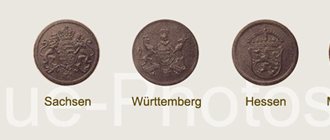
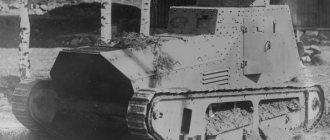
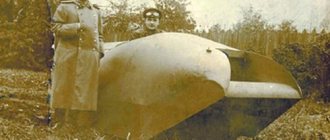
!['Domestic small arms [studio "Wings of Russia"] (2011)'](https://knifesburg.ru/wp-content/uploads/otechestvennoe-strelkovoe-oruzhie-studiya-krylya-rossii-2011-330x140.jpg)
